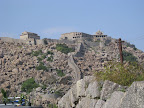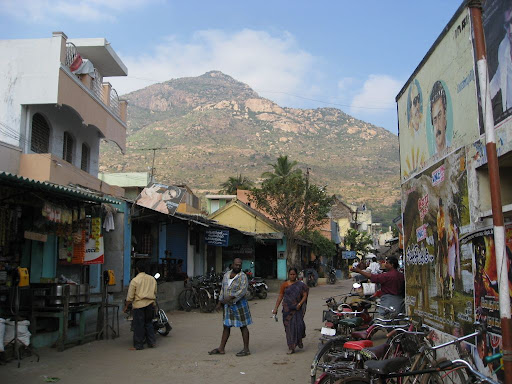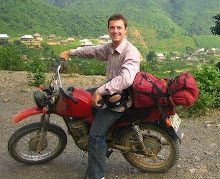Cameron and I were thinking of renting motorcycles and taking a day trip to a nearby town called Ginjee that has some incredible ancient hilltop forts before heading south to another temple city. However, we were advised not to make the trip because it was the last day of Pongal - their harvest festival. (Aka - everyone would be driving around wasted on local liquor and beer... not too safe..) We changed our plans and decided to catch a bus past Ginjee to another town called Tiruvannamalai, which is known as one of the holiest cities in India - a site of some serious pilgrimage, and also a magnet for a very interesting group of Westerners who have immersed themselves in Indian-Shanti culture.
Luckily on this bus ride I was feeling much better, and it only took us about 15 minutes to snag seats. About half way to Tiruvannamalai the landscape started to change. Instead of low coastal farms and jungle with pollution, chaos, garbage, and everything else that comes with overpopulated urban India, we began to drive past pleasant rice paddies and the strangest hills I have ever seen. Rather than rolling mounds of earth, these hills were piles of smooth granite boulders. They looked completely impossible. It is as though one of the Hindu gods gathered armfuls of stones and sprinkled them into mountainous piles across an otherwise flat landscape. As we passed through Ginjee we saw the fort perched high above the road on one of these granite mountains - definitely worth the trip that we didn't take.
Instead of low coastal farms and jungle with pollution, chaos, garbage, and everything else that comes with overpopulated urban India, we began to drive past pleasant rice paddies and the strangest hills I have ever seen. Rather than rolling mounds of earth, these hills were piles of smooth granite boulders. They looked completely impossible. It is as though one of the Hindu gods gathered armfuls of stones and sprinkled them into mountainous piles across an otherwise flat landscape. As we passed through Ginjee we saw the fort perched high above the road on one of these granite mountains - definitely worth the trip that we didn't take.
Eventually we approached Tiruvannamalai - the holy city nestled as the base of an enormous inactive volcano (probably the ancient cause of all the granite piles - although I prefer the image of Vishnu haphazardly scattering mounds of giant pebbles). The town itself was hot, stuffy, and crowded (recurring theme..) But we decided to walk toward the southern side of the volcano/mountain in search of a famous ashram where we would inquire into studying a little yoga or meditation.
But we decided to walk toward the southern side of the volcano/mountain in search of a famous ashram where we would inquire into studying a little yoga or meditation.
While we were in Mammalapuram we decided to look into ashram life. Cameron had had very little experience with Indian spirituality or anything to do with hippies, and I (being a product of hippie parents) had learned some meditation techniques from my mom and tried out yoga for a summer, so we figured it would be exciting to spend a week or two at an ashram - 5am to 10pm schedules of yoga, meditation, vegetarianism, and abandonment of all sex, drugs, and rock & roll. Crunchy, I know, but we wanted the challenge. (Or maybe I was just jealous that my mom had a guru..)
As we meandered down the road away from the main part of the city, we entered a much crunchier, much hippier, and much Birkenstock-ier part of Tiruvannamalai. We passed some psychedelically painted holy cows and Westerners dressed in Indian style cotton clothes and saris. We found our way through a village with brilliantly colored local huts mixed in with Ayurvedic spas, tourist tchotchkes, Hindu temples, and German restaurants. Eventually we found the ashram - the residence and former school of a widely followed guru who spent 20 years meditating in a cave on the mountain before founding this very peaceful school and community. Thousands of pilgrims visit this ashram and this mountain yearly to pay their respects. Unfortunately for our purposes, the ashram is mostly closed to students and only true devotees are allowed to stay. We walked around the campus which seemed to be run and protected by peacocks, and we looked in on a very lively chanting and meditation session. We decided to search around for an ashram that would let us study, and it seemed promising as there were apparently dozens in the town.
For dinner, we stopped in at a relaxed rooftop cafe with lounge pillows, incense, tabla music, and Italian food, where we got our first real taste of the Westerners who decide to make pilgrimages to India -- a VERY curious breed of people.. In the US they would mistakenly be labeled hippies, but that doesn't come close to capturing the essence of this group. We tried to figure them out as we sat there surrounded by them and as we wandered through the town, which was full of them, but it was still hard to form an opinion. They have a unique set of social rituals which seem to stem from spiritual Indian culture, but are definitely adapted by and for Europeans. They speak with a very calm, focused disposition and they touch and embrace each other for longer than would be socially acceptable in the States. It's like they have abandoned normal customs, and adopted this alternative lifestyle of peacefulness, simplicity, and serious hallucinogenic drugs. I feel like I'm doing a Discovery Channel documentary. Anyway - very interesting people. We met some German members of this species, and they told us about the town and all of the gurus that come to give enlightened lectures. We concluded, however, that we probably wouldn't find the yoga and meditation classes. On our way back into the city we passed masses of pilgrims hopping back on buses to head home and we witnessed another very real aspect of India, even today - a group of homeless men and women lying on the side of the road outside the western temple gate watching as a man severely beat his wife with a bamboo rod as she wailed for mercy at his feet. "Disturbing" doesn't capture it..
we sat there surrounded by them and as we wandered through the town, which was full of them, but it was still hard to form an opinion. They have a unique set of social rituals which seem to stem from spiritual Indian culture, but are definitely adapted by and for Europeans. They speak with a very calm, focused disposition and they touch and embrace each other for longer than would be socially acceptable in the States. It's like they have abandoned normal customs, and adopted this alternative lifestyle of peacefulness, simplicity, and serious hallucinogenic drugs. I feel like I'm doing a Discovery Channel documentary. Anyway - very interesting people. We met some German members of this species, and they told us about the town and all of the gurus that come to give enlightened lectures. We concluded, however, that we probably wouldn't find the yoga and meditation classes. On our way back into the city we passed masses of pilgrims hopping back on buses to head home and we witnessed another very real aspect of India, even today - a group of homeless men and women lying on the side of the road outside the western temple gate watching as a man severely beat his wife with a bamboo rod as she wailed for mercy at his feet. "Disturbing" doesn't capture it..
The next day I went exploring, and I visited the city's enormous Hindu temple - apparently one of the biggest in India. Afterward, I found a trail leading up the mountain through a neighborhood of small hillside shanties. The people were friendlier on the way up the hill, and I passed a few Hindu shrines where locals invited me to see their deities and caves. After noticing that the rest of the hikers passing me were shoeless, I decided to do the same. I happened upon the cave where the famous guru had spent 20 years meditating, and I walked inside - completely dark, cool, and quiet, except for a lone candle on an altar. When my eyes adjusted, I realized that there were about seven other people around the perimeter of the cave meditating silently. I took off my backpack and felt my way up onto a ledge where I bumped into a pillow. I sat down and spent about an hour meditating in the complete silence of this very holy spot.
Emerging refreshed, I continued my hike up the mountain - passing a small, hillside ashram and lots of monkeys. There was an old woman selling bananas for 4 cents each, so I bought two and climbed to the top of a boulder where I had my snack and enjoyed the stunning view of the city and its colossal temple. My hike ended at the ashram where I was the day before - very peaceful afternoon.
I met up with Cameron, and we got on a bus to a town called Madurai - another famous temple city where we spent a day before continuing on to the next state - Kerala. We never found our ashram in Tamil Nadu, but we hadn't ruled out the possibility of finding one down the road.
Luckily on this bus ride I was feeling much better, and it only took us about 15 minutes to snag seats. About half way to Tiruvannamalai the landscape started to change.
Eventually we approached Tiruvannamalai - the holy city nestled as the base of an enormous inactive volcano (probably the ancient cause of all the granite piles - although I prefer the image of Vishnu haphazardly scattering mounds of giant pebbles). The town itself was hot, stuffy, and crowded (recurring theme..)
While we were in Mammalapuram we decided to look into ashram life. Cameron had had very little experience with Indian spirituality or anything to do with hippies, and I (being a product of hippie parents) had learned some meditation techniques from my mom and tried out yoga for a summer, so we figured it would be exciting to spend a week or two at an ashram - 5am to 10pm schedules of yoga, meditation, vegetarianism, and abandonment of all sex, drugs, and rock & roll. Crunchy, I know, but we wanted the challenge. (Or maybe I was just jealous that my mom had a guru..)
As we meandered down the road away from the main part of the city, we entered a much crunchier, much hippier, and much Birkenstock-ier part of Tiruvannamalai. We passed some psychedelically painted holy cows and Westerners dressed in Indian style cotton clothes and saris. We found our way through a village with brilliantly colored local huts mixed in with Ayurvedic spas, tourist tchotchkes, Hindu temples, and German restaurants. Eventually we found the ashram - the residence and former school of a widely followed guru who spent 20 years meditating in a cave on the mountain before founding this very peaceful school and community. Thousands of pilgrims visit this ashram and this mountain yearly to pay their respects. Unfortunately for our purposes, the ashram is mostly closed to students and only true devotees are allowed to stay. We walked around the campus which seemed to be run and protected by peacocks, and we looked in on a very lively chanting and meditation session. We decided to search around for an ashram that would let us study, and it seemed promising as there were apparently dozens in the town.
For dinner, we stopped in at a relaxed rooftop cafe with lounge pillows, incense, tabla music, and Italian food, where we got our first real taste of the Westerners who decide to make pilgrimages to India -- a VERY curious breed of people.. In the US they would mistakenly be labeled hippies, but that doesn't come close to capturing the essence of this group. We tried to figure them out as
The next day I went exploring, and I visited the city's enormous Hindu temple - apparently one of the biggest in India. Afterward, I found a trail leading up the mountain through a neighborhood of small hillside shanties. The people were friendlier on the way up the hill, and I passed a few Hindu shrines where locals invited me to see their deities and caves. After noticing that the rest of the hikers passing me were shoeless, I decided to do the same. I happened upon the cave where the famous guru had spent 20 years meditating, and I walked inside - completely dark, cool, and quiet, except for a lone candle on an altar. When my eyes adjusted, I realized that there were about seven other people around the perimeter of the cave meditating silently. I took off my backpack and felt my way up onto a ledge where I bumped into a pillow. I sat down and spent about an hour meditating in the complete silence of this very holy spot.
Emerging refreshed, I continued my hike up the mountain - passing a small, hillside ashram and lots of monkeys. There was an old woman selling bananas for 4 cents each, so I bought two and climbed to the top of a boulder where I had my snack and enjoyed the stunning view of the city and its colossal temple. My hike ended at the ashram where I was the day before - very peaceful afternoon.
I met up with Cameron, and we got on a bus to a town called Madurai - another famous temple city where we spent a day before continuing on to the next state - Kerala. We never found our ashram in Tamil Nadu, but we hadn't ruled out the possibility of finding one down the road.

1 comment:
You are your Mama's son.....this one made me smile as I imagined you on your quest. If you don't find an ashram that allows you for a brief visit....just find a quiet spot anywhere that feels right (like you did in the cave)and use your mantra. This stuff works wherever you are...
Love ya, Mom
Post a Comment